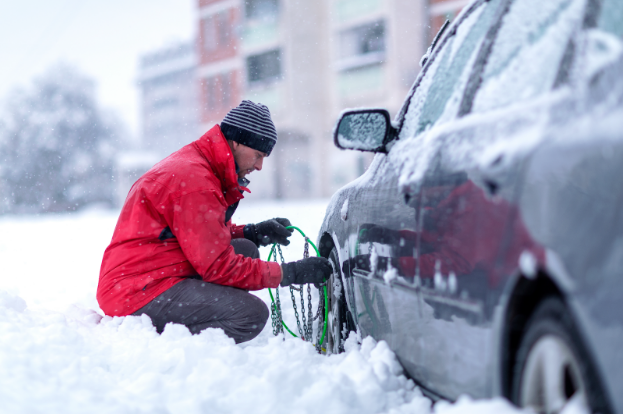
Tips for Driving in Snow & Ice
- Vehicle Maintenance
- PEAK
- January 3, 2024
As the snow season is upon us, ensure you and your vehicle are prepared for the winter. For safety tips about driving in the snow and ice, read our blog here!
Winter is a great time to break out your skis and snowboard to enjoy the thrill of speeding down a mountain — but that doesn’t mean you want the same experience in your car on the way home from work.
Driving in ice and snow requires a different skill set that might even seem counterintuitive to most drivers. Before you head out on an especially wintry evening, brush up on these safety tips to ensure you and your family make it to your destination without any slip ups.
Prepare Your Vehicle
Tires
If you know you’ll be dealing with icy roads multiple times this season, it’s time to put on the winter tires. These will provide you with extra traction to prevent skids.
When roads are completely covered in snow or ice, it could be useful to break out the tire chains that your dad always insisted you keep in the trunk. If you have tire chains, make sure you know how to place them on your car. Any improper installment or use could cause damage to your vehicle, leaving you stranded in the cold.
Here are a few quick reminders for how to use tire chains:
- Never use them on bare pavement, only on snow and ice
- Don’t drive over 25 mph
- Avoid slamming on brakes as much as possible
- Pull over immediately if you hear any noises coming from the chains
- The Department of Transportation may close roads and only allow vehicles with tire chains to proceed (even for trucks or Jeeps)
If you drive a commercial vehicle, check local laws to see what kind of chains may be required to stay on your route. Some states only require chains on outside drive tires, where others require a minimum of four tires to be chained during severe conditions.


Headlights
It’s not all about your tires, though. Visibility is also key to staying safe during a snowy road trip. Before you hit the road, always check your headlights, and replace both if you notice that one is out, or if they look hazy or yellow in color. Headlights that aren’t functioning properly can reduce visibility by up to 80%, so it’s a good idea to replace old ones with high-performance halogen headlights that will provide better protection when you’re driving in snow.
Even if your headlights are brand new, misalignment can reduce your visibility and reaction time. Any time you hit a bump on the road, your headlights could shift slightly and make it more difficult to see. Before any winter trip, checking your headlight alignment should be on your to do list.
Wiper Blades
You should also check and care for your wiper blades. If you’re driving through heavy snow (or even just a rainstorm), you need them to wipe away precipitation so you can see the road. One very important rule: don’t run your wipers across a frosty windshield. Your wipers can get stuck on snow or ice and snap from the pressure, leaving you with compromised visibility for the rest of your drive. Even if you’re running a few minutes behind, give yourself enough time to defrost the windows completely.
As a rule of thumb, you should check and replace your wiper blades as often as every six months. This is especially important in the winter. Make sure to choose durable wiper blades that can stand up to extreme temperatures.
Complete your pre-drive prep with windshield wash. Dirty windshields covered with smears, dust and streaks can make it difficult to see, rendering your headlights and wipers useless. Give yourself a clean, safe start to your drive with a high-quality windshield wash that can melt snow and ice.
Drive Slow & Steady
If you must head out in unfavorable weather, you need to be extra careful on the roads. Ice and snow reduces your tire traction, which can cause scary, uncontrollable skids across the road. Your goal throughout your drive is to retain as much tire traction as possible.
That means lower speeds and steady motions. Any turns, braking, and accelerations you make are opportunities for your car to skid. Keep your speed low to prevent jerky turns or slamming on brakes at obstacles.
New drivers — we know you’re excited to finally have freedom on the road. But without much driving experience, it may not be safe for you to take your car out during a major winter storm. You’ve probably never felt your car hydroplane or skid, and even experienced drivers can panic when things go awry. If you absolutely have to drive in snow, drive even slower than you think you need to and be ready to slow down at any time.
Also, know your route well before you set out on the road. Normally it’s fine for your GPS to let you know to turn in 500 feet, but in snow, you might find yourself spinning out instead.
Know How to Use Your Brakes
The last thing you want to do on snow is slam on the brakes. Just like a hard right turn could cause you to lose control, a hard slam on the brakes could do the same. In order to properly stop in an icy emergency, you need to know your car and braking system.
While most drivers know that slamming on the brakes is dangerous (in any conditions), many aren’t as familiar with the dangers of locking the brakes. In older cars, when your car starts to skid, your brakes may lock up and prevent you from regaining traction. If your car isn’t equipped with an anti-lock braking system (ABS), slowly pump your brakes when you need to slow down in order to avoid brake locking.
Most new cars are built with ABS, which should prevent your brakes from seizing up, even on a hard stop. If you know your car has ABS, firmly apply pressure to your brakes until your car comes to a complete stop and let the technology do the work.
Drive Defensively
You might be comfortable driving in icy conditions, but that doesn’t mean other drivers on the road are as experienced as you. Even if you’re doing everything right, you could still get in a wreck with another driver at fault. To protect yourself from other drivers, put extra distance between your car and the car in front of you, allowing yourself plenty of time to stop if necessary.
What To Do If Your Car Skids
Even taking all of these precautions, you might find yourself skidding across your lane. But you still have a chance to smooth your course.
First of all, do not panic. Easier said than done, but keeping your wits about you will allow you to make better, safer decisions. Then, take your foot off the gas. Any further acceleration or sudden braking could cause a spin out, so you want to slow the car without any knee-jerk reactions.
Next, look in the direction of safety. This would be a shoulder or open area where it would be safe for your car to end up. Keep your eyes focused on where you want to go and that will help you steer there, even in the most frazzled of states.
Finally, assess the situation. If you feel the rear of your car skidding in one direction, gently steer into that direction to correct it. If you feel that you don’t have control of your steering wheel anymore, gently turn it to straight and allow your car to slow to a stop. These maneuvers should prevent you from exacerbating the issue or careening into other vehicles.
This holiday season, stay safe and prepared for all of your travel. Find out more about PEAK products and how we can help you protect your car this winter by visiting PEAKAuto.com.

